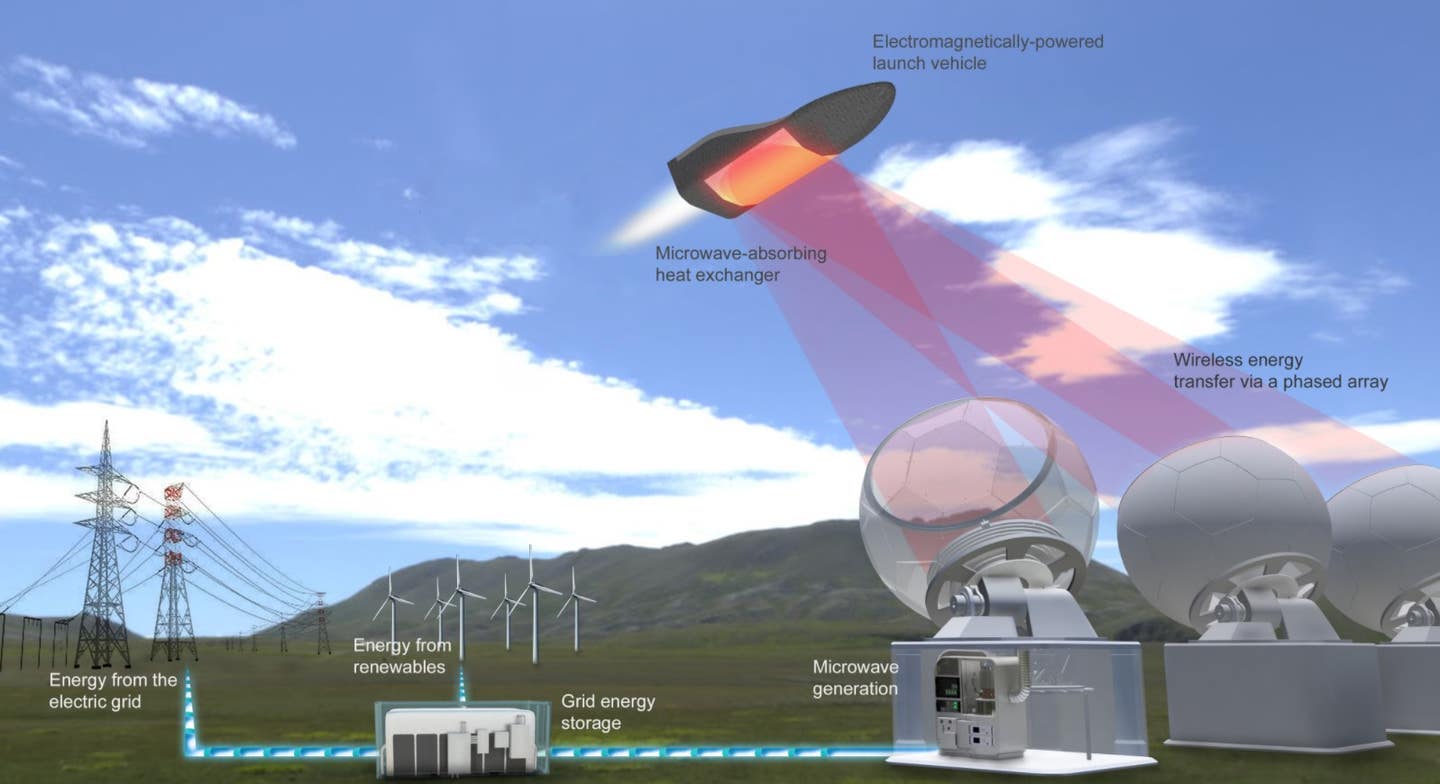Flying into space on a microwave-propelled rocket
A research team from Japan has investigated the viability of using such microwave-powered propulsion for real-world applications.

[July 1, 2022: Kohei Shimamura, University of Tsukuba]
Researchers have demonstrated wireless power transmission via microwaves for a free-flying drone. (CREDIT: Escape Dynamics)
Sending a rocket into space typically requires about 90% of the rocket’s initial weight to be fuel. This limitation could be overcome by wirelessly transmitting the needed power to the rocket through a beam of microwave radiation. A research team from Japan has investigated the viability of using such microwave-powered propulsion for real-world applications.
In a study published in the Journal of Spacecraft and Rockets, researchers led by the University of Tsukuba have demonstrated wireless power transmission via microwaves for a free-flying drone and determined the efficiency of this process.
In the beginning of the 20th century, it occurred to Russian rocket scientist Konstantin Tsiolkovsky that there was another way: by keeping the energy source on the ground and beaming the required power to a rocket, it could be launched with very little fuel on board.
Early this year, scientists in Japan successfully “launched” a tiny metal rocket using an unusual source of thrust - microwaves. (CREDIT: Kohei Shimamura, University of Tsukuba)
Related Stories
Previous analyses of this kind were carried out decades ago and mostly considered microwaves of a low frequency (a few gigahertz; GHz). Given that the power transmission efficiency increases as the operating frequency is raised, the team behind this latest research used microwaves with a relatively high frequency (28 GHz). The team’s drone weighed roughly 0.4 kilograms and hovered for 30 seconds at a height of 0.8 meters above the source of the microwave beam.
Using this beam, the scientists were able to send pulses of microwave energy into the bottom of their hollow 126 gram rocket model. (CREDIT: Kohei Shimamura, University of Tsukuba)
“We used a sophisticated beam-tracking system to ensure that the drone received as much of the microwave power as possible,” says Kohei Shimamura, lead author of the study. “Moreover, to further increase the transmission efficiency, we carefully tuned the phase of the microwaves using an analog phase shifter that was synchronized with GPS units.”
The researchers measured the efficiencies of the power transfer through the beam (4%), the capture of microwaves by the drone (30%), the conversion of microwaves to electricity for propulsion (40%), and other relevant processes. Based on this information and an analytical formula, they calculated the overall power transmission efficiency in their experiment to be 0.43%. For comparison, in a previous study, the team measured the total transmission efficiency for a fixed-position (rather than free-flying) drone to be 60.1%.
“These results show that more work is needed to improve the transmission efficiency and thoroughly evaluate the feasibility of this propulsion approach for aircraft, spacecraft, and rockets,” explains Shimamura. “Future studies should also aim to refine the beam-tracking system and increase the transmission distance beyond that demonstrated in our experiment.”
Environmental Impact of Traditional Solid Rocket Motors
Solid rocket motors (SRMs) help many heavy-lift rockets off the ground. Most well known are possibly the solid rocket boosters of NASA's space shuttles, which burned a mixture of aluminum and ammonia, and were not exactly an environmental win.
Some rather strange occurrences were reported after space shuttle launches. The massive cloud generated during liftoff contained rather reactive chemicals such as hydrochloric acid and aluminum oxide. These substances got mixed up with water from the deluge system that cooled down the launch pad and the rocket. This cloud then spread in the surrounding environment, affecting soil and water quality, and damaging vegetation, according to the review.
After several space shuttle launches, large amounts of dead fish were found in nearby water bodies, a study cited in the review reported. Scientists then experimented with open, closed and partially closed buckets with water that were left near the launch site during liftoff. They found that as stuff from the space shuttle cloud rained into the buckets, the water inside turned into a mild acid. Fortunately, in nature, the water PH quickly returned to normal (although not quickly enough for the dead fish).
In the 1990s, scientists flew high-altitude planes through the space shuttle exhaust plumes. They wanted to know what the chlorine from the exhaust did to the ozone layer. They indeed found local ozone holes in the rocket's wake, David Fahey, the director of the Chemical Sciences Laboratory at the National Oceanic and Atmospheric Administration, who led the research, said in an earlier interview. But the holes healed quickly after each launch and were not large enough to affect the ozone layer globally. At least not at the frequency of launches at that time.
But there are still other components of the SRM exhaust that scientists still don't fully understand and are concerned about. The aluminum oxide from the exhaust forms particles that might reflect sunlight and thus change how much heat reaches Earth's surface. These particles get injected into the otherwise pristine upper layers of Earth's atmosphere, the stratosphere and the mesosphere, and potentially trigger temperature changes.
Although microwave-powered rocket propulsion is still in its early stages, it could someday become a superior way to launch rockets into orbit given the high onboard-fuel demands and environmental impacts of conventional propulsion techniques.
Note: Materials provided above by University of Tsukuba. Content may be edited for style and length.
Like these kind of feel good stories? Get the Brighter Side of News' newsletter.



